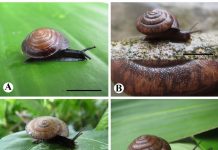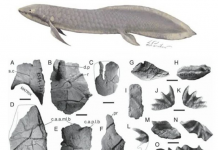Assistant Professor Dr Wilawan Promprom and Assistant Professor Dr Wannachai Chatan, SCIMSU researchers from the Department of Biology at Mahasarakham University, published a new article, “New Medicinal Plant Variety of Trichosanthes tricuspidata Lour. (Cucurbitaceae) from Northeastern Thailand,” in Pharmacognosy Journal (2018).
ABSTRACT: Objectives: This research was carried out for describing, illustrating and treating a new medicinal plant variety in the genus Trichosanthes. Methods: This research was carried out by collecting plant specimens in the Northeastern Thailand. Morphological characters were studied and compared with the closely related taxon and taxonomic literatures. Results: T. tricuspidata subsp. rotundata var. longirachis, was found. This plant is described and illustrated here and treated as a new variety. It differs from the other of T. tricuspidata subsp. rotundata by having the following combination characters: Comparatively stout herbaceous climber up to 20 m long, tendril 3–5-brached, probract obovate with obvious glands, mature blade unlobed or 3-shallowly lobed with 1-2 short angles, blade not deeply lobed (unlobed blade found in juvenile plants), blade size 5-11 cm diameter and raceme rachis length 10–130 cm. Its fruits and seeds were used as medicinal parts. Conclusion: Totally, three subspecies and four variety of T. tricuspidata in Thailand have been recorded so far. Important comparative morphological characters with some closely related variety are discussed. The local people used it as medicinal plant.
Trichosanthes tricuspidata Lour. subspecies rotundata W.J.de Wilde and Duyfjes var. longirachis Chatan and Promprom, var. nov.
Type: THAILAND, Kanthawichai district, Maha Sarakham Province, location 48Q 0312952 UTM 1796680, alt. 140–150 m, 18 June 2013, W.Chatan 1626 (Holotype: MSUT!)
Diagnosis: The new plant variety differs from T. tricuspidata Lour. subsp. rotundata W.J.de Wilde and Duyfjes var. rotundata by having the following combination of characters: comparatively stout climber up to 20 m long, tendril 3–5-brached, probract obovate with obvious glands, mature blade unlobed or having 3-shallowly lobed with 1-2 short angles, not deeply lobed (unlobed blade found in juvenile plants), blade size 5-11 cm diameter and raceme rachis length 10–130 cm.
Flowering and fruiting: Flowering of male flowers in April–August. The flowering of female flowers is unknown. Fruiting in July-September.

Distribution: T. tricuspidata subspecies rotundata var. longirachis is endemic to Thailand and known from Ban Phai District, Khon Kaen Province, and Kanthawichai District, Maha Sarakham Province, Northeastern Thailand.
Ecology: This species grows in dry dipterocarp forest or near roadside at an elevation of 130–150 m. It climbs on shrubs or trees in slightly dense or open areas.
Vernacular name: Tam Lueng Kok and Khi Ka (ตำลึงโคกหรือขี้กา)
Etymology: The name of variety is named after the distinct morphology of this plant, i.e the very long rachis of inflorescence.
Uses: The local people use this plant variety as a medicinal plant. Its fruits and seeds were used as purgative. The seeds were used as laxative.
Additional specimen examined: W.Chatan 1630 (MSUT), THAILAND, Ban Phai District, Khon Kaen Province.
Chatan W, Promprom W. New Medicinal Plant Variety of Trichosanthes tricuspidata Lour. (Cucurbitaceae) from Northeastern Thailand. Pharmacog J. 2018;10(1):29-32.






